BUYING & OWNING
Although the factory built cars are now 18 years old, second hand prices have not dropped significantly in the last 10 years, with a good example still fetching around £10 - 12k. Most of these are low mileage, as few sane individuals would use a G33 as an everyday road car. The owners club magazine is a good point to start to look for a second hand one. As built by the factory the cars are of a mostly pretty good standard, but at this age there are a few points to check for:
CHASSIS
In most cases this has only a coat of black paint, so check for corrosion. A few were galvanised however. Otherwise just a basic ladder chassis, that behaves as such.

This photos shows the levels of corrosion between 2 similar aged cars with the rear body removed, the one on the left has had regular Waxoyle treatments, the other has not!
DRIVE TRAIN
Everything is pretty tough and mostly Sierra Cosworth. Disks are huge and vented, but without a servo, leading to a firm pedal. In a car of this weight disk and pad wear is pretty minimal. Again rear suspension bushes can be a problem, as if these are worn the car will kick sideways between gears at high speed as the wishbones move as the power is applied. The rear differential mountings are not strong enough for higher power outputs however and will need bracing if the engine is tuned, and the mounting bolts can come loose and worth checking. Two bolts are behind the fuel tank, or it is possible to just get to them from underneath with an open ended spanner, but its very tight space indeed.
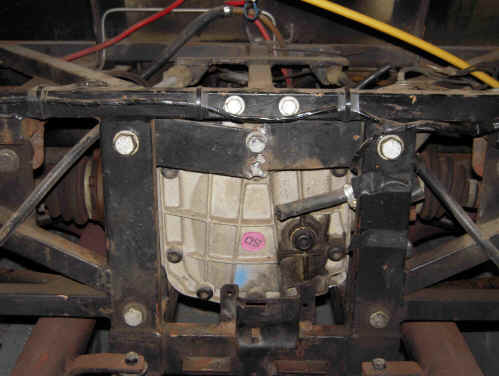
These are the mountings that shear found behind the fuel tank.
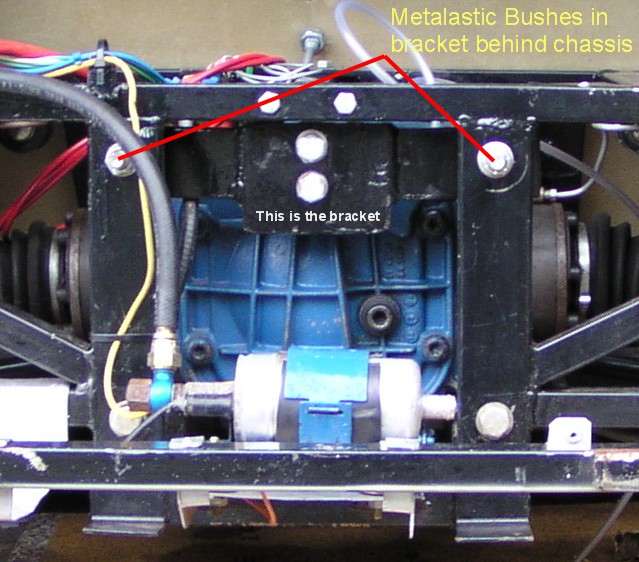
This is the fix, a simple extra plate welded on
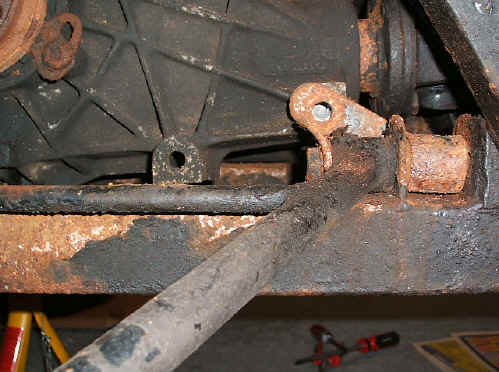
Once the diff starts to twist, the bolt holes elongate and the securing bolts fall out. Time to remove the rear body and diff for a set of Hele coils. Its thought this particular cars chassis had been exposed to sea water, as they are not normally this bad!
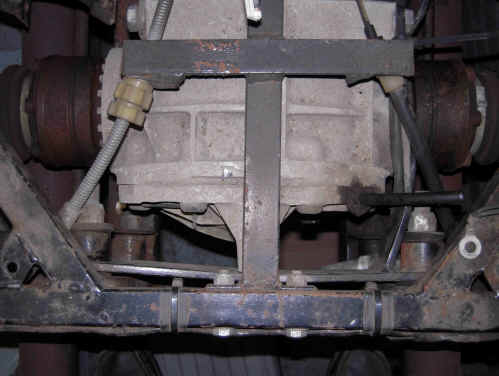
Route of the problem, for some reason Ginetta only mounted the upper diff mounting holes on the right hand side, so the forces on the center bracket are uneven as the diff twists.
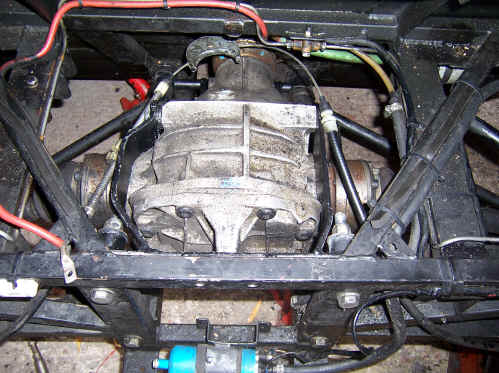
A modification, with the addition of an extra bracket on the left hand side, a difficult modification as its all a very tight fit. The easiest option is to ensure the diff mounting bolts don't come loose in the first place. Fit new bolts, the strongest screw lock you can get, and shake proof washers if you don't want to go to all this effort!
SUSPENSION
The rubber metaplastic joints should have been replaced by now, and if not will be perished. This will lead to poor handling with undesirable movement of the wishbones. You can fit harder bushes but the ride becomes very hard in the process, so for road use stick to rubber. They are not expensive to replace, but setting up the correct chassis alignment afterwards takes some time and skill. The rose joints can wear, but are also easy to replace. Take a note of the exact number of turns the rose joint is turned to, to retain the original geometry when replaced. Also check for uneven tyre wear, such as scrubbed inner or outer edges, or highly worn centres. These can all be signs of incorrect geometry that will need correcting. (See the Chassis pages for more info.)
TYRES
The original Goodyear Eagles had a tendency to wear out the centre very rapidly. Part of the problem was that the G33 was so light that tyre pressure needed to be exact. Too soft and the tyre side walls moved too much and the handling suffered, whilst too hard the tyre centre bowed out and would wear before the outsides of the tyre. A compromise was reached at around 22psi. The original design was to run a 195 x 15 50% profile, but this gave a small wheel diameter, so was increased to 215 x 15 50. A tyre of this width with so much grip will tend to steer the car over poor surfaces, so narrower ones can be fitted to enhance the steering. (I run a 205 x 15 55 as a compromise between grip and handling). (See the pages for more info.)
ENGINE
Unmodified this Rover V8 engine is bullet-proof. Maximum power is at around 5200 rpm, so there is no need to rev it hard. As long as it has had good quality antifreeze used and regular oil changes this should not give any problems and can be easily serviced at home. Some of the cars however did show fuelling problems (running lean) with the Lucas hotwire ECU system due to the different installation in the Ginetta over the Range Rover. A quick check of the plugs will show if this is the case, as the plug tips will be completely white when they should have a light tan colour. The fix is a re-chip of the ECU or increase the fuel pressure with a variable fuel pressure regulator. (See the Engine & Gearbox page for more info). Some cars also showed a limited top speed because the original ecu map was for an off road vehicle, but unlimited the cars top speed is around 135mph.
A big engine like this may use some oil on modern thinner oils, and is not a problem as long as it is checked regularly. I personally thing the Castrol Magnatec for conventional engines is a good option, being a slightly heaver oil. The idle stabilising system can lead to a high tick over for short periods, but will slow after a few seconds. This is not a major problem, except when selecting reverse. (See below).
GEARBOX
Slow and clunky and of Land Rover origins (LT77). If the clutch drags at all or the engine spigot bearing is tight, reverse will grind as its selected. This means waiting for the tick over to drop before selecting it unless you want a gearbox full of broken teeth. The best option is to select first gear with the clutch depressed then go into reverse, as this stops the gears spinning. Not much good in an autotest! The final drive ratio is a little high, so the gear spacing is very wide, but with the power spread of the big V8 is not really a problem. Land Rover did recommend automatic transmission fluid be used, but this causes premature bearing failure so a modern synthetic oil should be used. Also see the Engine and Gearbox page.
BODYWORK
The mouldings on the G33 are really good and well made, and could certainly show TVR how it should be done (back then anyway). There are only a few points to check, like the nose cone for accident damage, as there are no bumpers to take ever a minor knock. Also the engine is very close to the bonnet, and cracks can appear next to the rear near side of the power bulge where the engine air intake sometimes hits the bonnet (Like hitting the gearbox/engine on a speed bump). The only fix is to lower the engine on its mounts (ground clearance becomes a problem then) or fabricate another smaller power bulge above the air intake for extra clearance. The doors take a lot of loading as the chassis flexes, so check for cracks long the doors and around the locks. Unfortunately there is no easy fix for this one. The seals that keep the water out don't fit well around the front of the doors that can lead to water ingress.
INTERIOR
Some have survived better than others. Mostly the problems are bits coming unstuck or general grime and sun damage. Nothing too difficult to re upholster or glue back. The glass fibre seat mouldings (on mine anyway) appear to have originally been wider and have been cut in half and re bonded to fit the cockpit. Not a very neat job but strong enough. Some cars are fitted with seat runners, and removing them can lower the seat a bit to keep the head out of the direct airflow over the windscreen. The Ford Escort switch gear for the centre console is pretty poor, with the latching actions failing. The heating system is from a Mini and warms the feet gently. Not adequate to de mist the screen unfortunately.
HOOD
Although a pain to put up and down, is basically adequate. There is a simple tensioning bar to tighten the hood once fixed in place, but this does not lock. If you drive without the windows in, the turbulence is enough to move this bar and loosen the hood at speed. A simple locking bar will fix this. Its also worth running a foam strip along the glass fibre mouldings that fits the roof to the windscreen surround. This helps keep out the water and protects the paint from damage.
ELECTRICS
The basic wiring is pretty good, with fuses located on a bulkhead on the passenger side. (see Electrical System page.) All the control relays are under the dashboard on the passenger side. One of these relays is for the cooling fans, and the connections to it are not really adequate for the large current drawn by both fans. This will melt the relay base and discolour the wiring. A bigger relay and careful reconnection with bigger spade joints will resolve this. The fans use a 30 amp fuse, and this heat buildup from the rear connections can melt the fuse holder. It is best to remove the spade clips from this fuse, and solder a good quality separate fuse holder that can take 30 amps. The headlights use a wiper motor to raise them and there have been issues with connection corrosion in cars that have been used in the winter months in this area. The headlight lifter mechanism arms pivot through simple nuts and bolts that wear out, so the headlights “chatter “ when up. At least new bolts are a must or a better option is to fit phosphor bronze bushes.
WHEELS
Ginetta used mostly Fondmetal Alloys that stayed looking good if treated with respect. Some other alloy brands were tried but corroded badly. The front wheels are spaced slightly to allow the wheels to clear the massive Cosworth brakes, but in doing so have increased to wheel offset, that increases the load on the front wheel bearings that wear rapidly (play will be apparent by 15000 miles). It also causes a some extra kickback through the steering over pot holes, though careful setting of the camber and toe in can minimise this.
EXHAUST
What can I say, both noisy and inefficient, and not plated in anyway so rust rapidly. Throw it away and construct your own or fit side pipes. Ginetta retained the standard restrictive cast manifold, so significant power gains can be made with a tubular manifold set-up.
GENERAL
Super car performance with 18 –20 mpg. Best used as a summer only fun car that’s both pretty and very unique. Handling in the wet can be pretty wild however with wide tyres and little weight. In the dry it has sharp handling (providing it set up correctly) and stonking V8 engine that will go from 15mph to 150mph in one gear. It can be used on track days but needs respect as it gets twitchy on the limit. Don’t try racing Subaru’s Impreza or Mitsubishi Evo’s (except in a straight line!) as you don’t have ABS or traction control, plus the chassis design is still pretty basic. Simply regard it as a modern day AC Cobra. Classic car limited mileage policies can make for very cheap insurance, so fuel is the only major running costs. Maintenance wise the cars simple construction makes things pretty easy, but don’t forget the potential for disaster in a car of this performance if things are not kept in shape. Safety wise the car does not have any sort of roll protection in standard form, as the windscreen is not significantly braced in any way so treat it with respect and simply enjoy it for what it is. Would I ever sell mine?
No.